August 2024
The global ureteral stents market size is calculated at USD 575.54 million in 2024, grew to USD 615.39 million in 2025 and is predicted to hit around USD 1,128.19 million by 2034, expanding at a CAGR of 6.96% between 2024 and 2034. The North America ureteral stents market size is evaluated at USD 212.95 million in 2024 and is expected to grow at a CAGR of 7.09% during the forecast year.
The global ureteral stents market size accounted for USD 575.54 million in 2024 and is expected to exceed around USD 1,128.19 million by 2034, growing at a CAGR of 6.96% from 2024 to 2034. A growing incidence of UTSDs, including kidney stones and obstructions, a growing geriatric population, technological innovations, and awareness amongst patients add to the ureteral stents market growth rate.
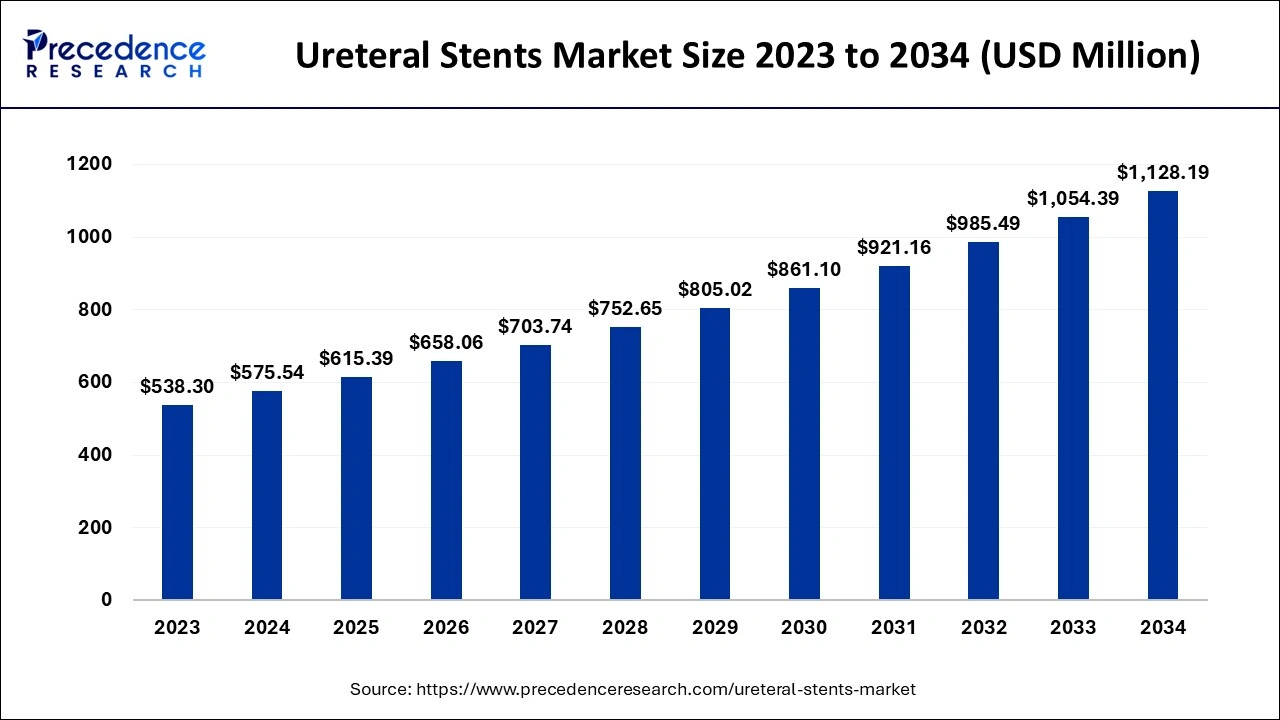
The use of machine learning (ML) and artificial intelligence (AI) capabilities can be beneficial to urologists and radiologists in diagnosing problems and, in the process, minimizing the costs of patients. AI is used in several urological diseases, including urolithiasis, pediatric urology, urogynecology, benign prostatic hyperplasia (BPH), renal transplant, and urooncology. AI is used in the ureteral stents market to analyze images, make diagnoses based on radiological images, and plan treatment. Also, AI techniques are implemented to analyze data, assist in predictive analytics, and forecast patient outcomes and disease progression.
The U.S. ureteral stents market size is evaluated at USD 149.06 million in 2024 and is projected to be worth around USD 298.27 million by 2034, growing at a CAGR of 7.16% from 2024 to 2034.
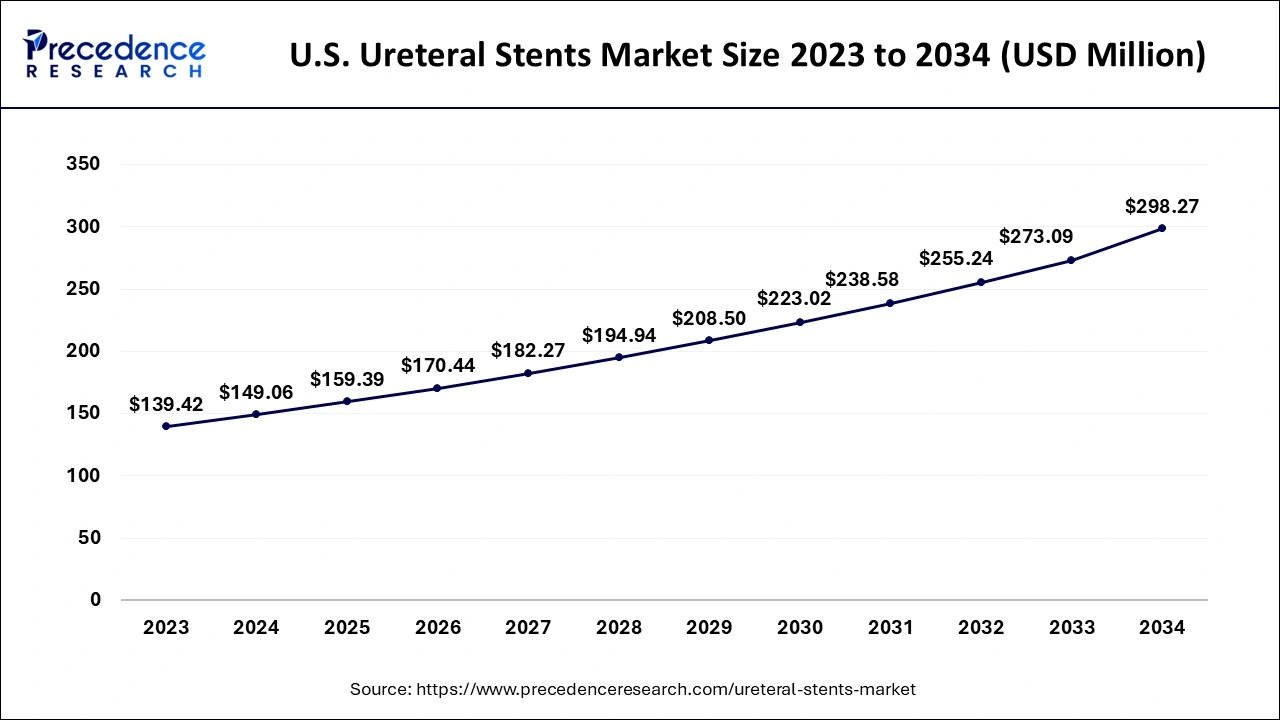
North America accounted for the largest share of the ureteral stents market in 2023. There is a developed healthcare system, and modern equipment and technologies help to deliver proper treatments. In addition, there is a growing of geriatric people, which results in high incidences of kidney-related diseases, increasing demand continually. The growth in kidney transplant surgeries and minimally invasive surgeries enlarges the need for ureteral stents.
Increase in the number of urological surgeries, the presence of major manufacturers in Asia Pacific, and the continued focus on research and development initiatives. The region has always adopted technological advancement in medical devices, diagnostic tools, and treatment. In addition, research and development emphasis in the medical facilities make the institution offer new products that are useful to the patients.
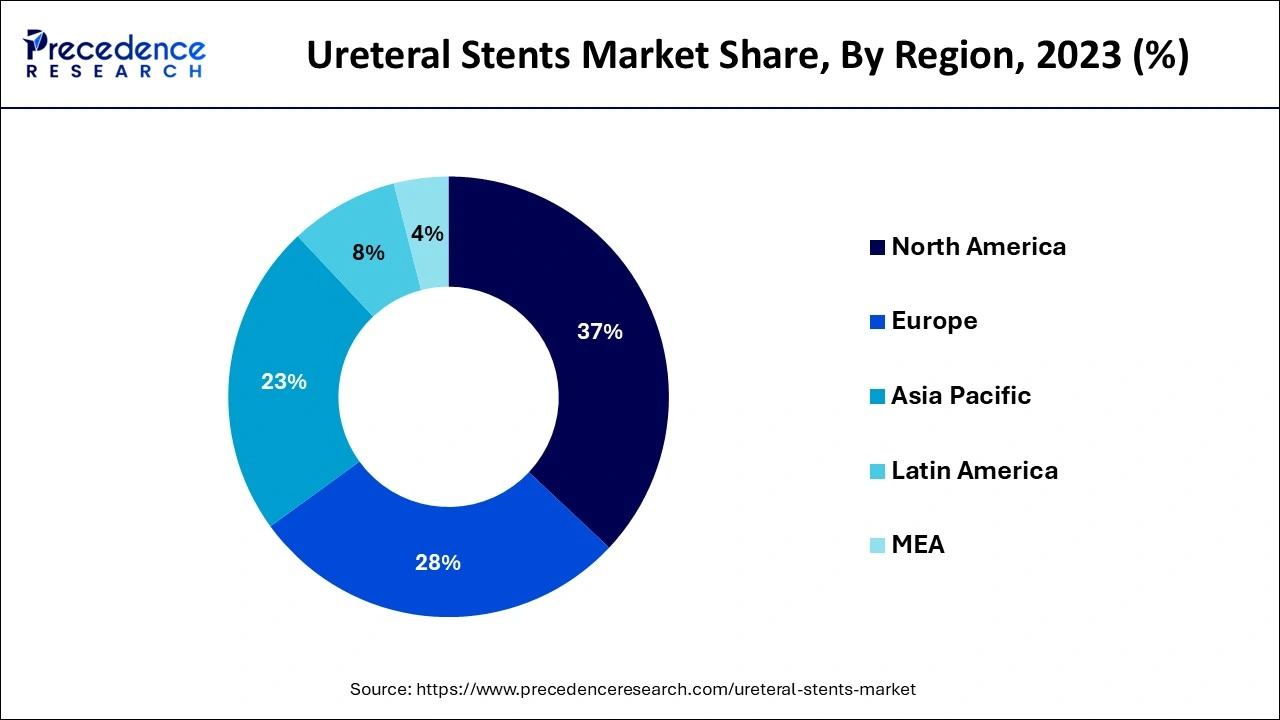
Asia Pacific is anticipated to witness the fastest growth in the ureteral stents market during the forecasted years. Higher incidences of urological problems due to urban life and changing lifestyles create demands, and medical tourism, especially in India and China, continues to rise. This is because of advanced medical tourism, the increasing cost of health care, and the escalating rate of osteoarthritis and degenerative disc disease.
China possesses the largest ureteral stents market, and India has the fastest-growing market. Ureteral stents are small and elastic tubes inserted for the management and prevention of obstruction in the ureters and are projected to rise in the Asia Pacific market. In addition, growth in this market through government efforts to increase healthcare spending is important.
Ureteral stents are slender tubing produced from materials that are medical grade and intended for placement within the ureters for a few days or weeks only. These stents are inserted into the body during surgical operations to correct obstruction or facilitate healing by preserving the patient’s urinary system. Ureteral stents are used to reduce associated complications in renal transplantation to reduce the incidences of urine leaks, ureteric stenosis, or obstruction. A double-J ureteral stent effectively manages routine postoperative mild leak and transplant ureter obstruction.
The major driver that has led to the increasing popularity of the ureteral stents market is the increase in kidney stone-related conditions. Currently, the incidence of kidney stones has been rising gradually all over the world as a result of diet, physical inactivity, and fluid intake. Since the kidney stone blocks the ureters, causing urine to accumulate between the kidneys and bladder, ureteral stents play a key role in discharging this obstruction and inhibiting complications such as hydronephrosis and renal damage.
| Report Coverage | Details |
| Market Size by 2034 | USD 1,128.19 Million |
| Market Size in 2024 | USD 575.54 Million |
| Market Size in 2025 | USD 615.39 Million |
| Market Growth Rate from 2024 to 2034 | CAGR of 6.96% |
| Largest Market | North America |
| Base Year | 2023 |
| Forecast Period | 2024 to 2034 |
| Segments Covered | Material, Application, and Regions |
| Regions Covered | North America, Europe, Asia-Pacific, Latin America, and Middle East & Africa |
Growing incidence of urological disorders
Increased incidence of kidney disorders, increased geriatric population, increased urbanization and changing lifestyle, and increased rate of sedentary living contributed to the growth of the ureteral stents market. Further, the rising incidence of kidney stones is a urology ailment that involves the deposition of solids in the renal parenchyma or the urinary tract, leading to a blockage of the ureter, life-threatening pain, and renal compromise. It is a major driver of the market. Also, the progression in the application of ureteral stents in such a situation to treat obstruction and to facilitate micturition to the patient, eliminating the necessity of a substantial procedure.
Growing demand for minimally invasive procedures
Laparoscopy and endoscopy are less invasive than the traditional open approach to urological disorders surgeries. There is preventative use in which the ureteral stents market products are used after surgery to help with ease of recovery as well as to minimize the occurrence of complications and to improve patient experience. These advanced techniques have necessitated the usage of these minimally invasive surgical instruments as part of urology practice.
Side effects and discomfort associated with the ureteral stents
After the placement of ureteral stents, many patients witness pain, dysuria, increased and more frequent urge to urinate, hematuria, increased susceptibility to UTI, migration of the stent, irritation of the bladder, and encrustation. Possible side effects include reversible nephrotoxicity, ureteral obstruction, nausea, and psychological effects. The possible late complications of the stent include stent migration, stent encrustation, and formation of stones and fragmentation, hindering the acceptance of the ureteral stents market. The main complications are VUR, LUTS, and stent-related complaints. The two complicated types of cystitis with the most frequent incidence rates are asymptomatic bacteriuria and urinary tract infection.
Technological enhancements in health care have a major role in the transformation and enhancement of the ureteral stents market procedures. These technologies have improved the modeling, positioning processes, and effectiveness of the ureteral stents, making them effective instruments for medical disorders. Advancements in materials science have been made by incorporating elements that help to reduce inflammation and encrustation, thus making patients a lot more comfortable and eliminating the need to have stents removed before schedule. Drug elution technology is also used, where the stents are coated with medications that can be gradually released to the ureter to neutralize effects such as inflammation or formation of infections.
In the ureteral stents market, the use of 3D printing technology revolutionizes stent design. Further, advances in the technology of 3D printing have allowed the creation of unique and appropriately shaped ureteral stents. Personalized stents help to minimize discomfort, provide fewer adverse reactions for patients, and increase satisfaction rates considerably, which can be considered a great step forward in the use of technology in the treatment of urological diseases.
The polymer ureteral stents segment noted the largest share of the ureteral stents market in 2023. Urological diseases include the rising prevalence of kidney stones and UTIs and require efficient remedies such as polymer stents. Ureteral stents are available in polyethylene, silicone, polyurethane, and biodegradable polymers. Many polymer-based stents incorporate highly biocompatible material, which means they are not rejected by human body tissues. Furthermore, polymer stents are more flexible than metal stents and can better follow the shape of the ureter, thus making their placement more comfortable for the patient and decreasing the chances of stent migration or irritation resulting from the stent not fitting properly in the urinary tract. It helps minimize the probability of forming tissue reactions, including inflammation, as compared to other stents from other materials that may be relatively incompatible with the biological milieu.
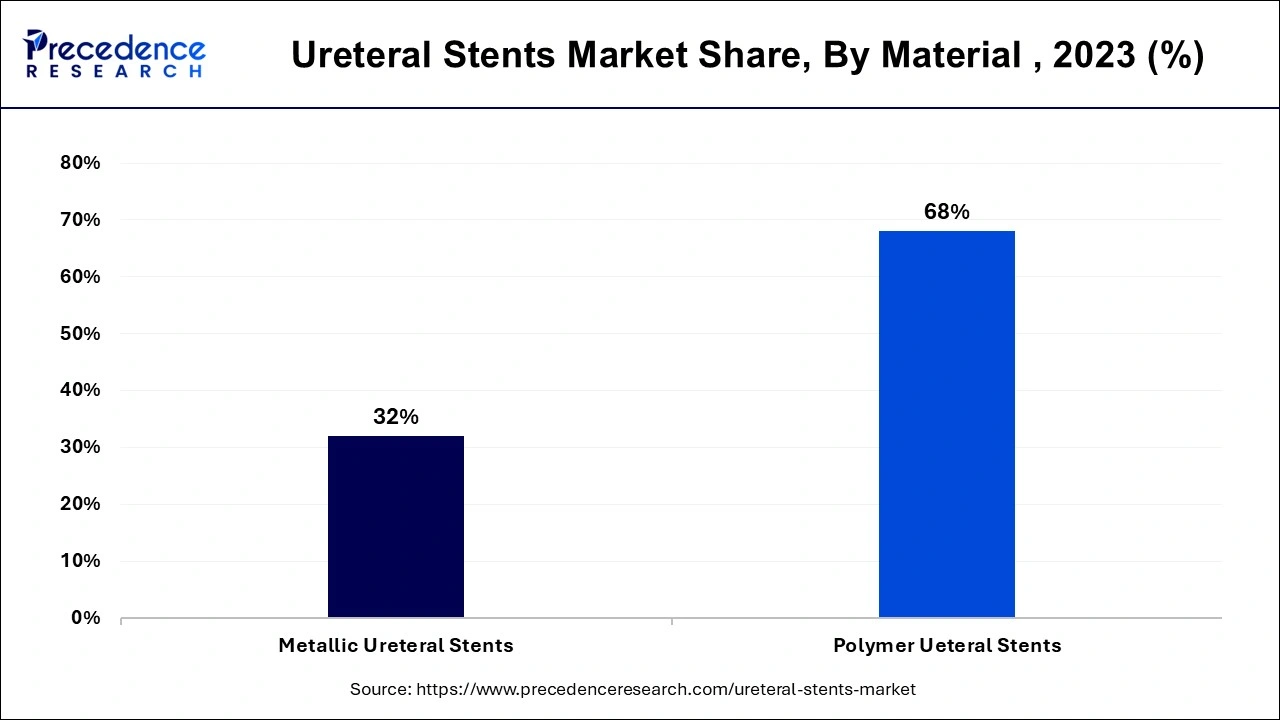
The metallic ureteral stents segment is projected to witness the fastest growth in the ureteral stents market during the forecast period. These stents do not require frequent replacement, although they could remain within a patient’s body for some time, which is advisable for patients with chronic diseases. Increasing incidences of end-stage renal disease patients and several urological procedures performed drive the market for metallic renal stents. The metal stents are usually manufactured employing nitinol or stainless steel, which are durable and have some enduring features. One of the major advantages of placing metal stents is that they last longer than other stents, hence allowing patient convenience with less frequent replacements.
The kidney stones segment has contributed the largest share of the ureteral stents market in 2023. Factors include lack of physical activity, increased rate of obesity at all ages, and poor diet. Kidney stones complicate the ordinary passage of urine, hence leading to severe pain and distress. This obstruction is regularly treated with the use of ureteral stents to facilitate the normal drain of urine. Because they physically mechanically alter the path and rate of urine flow through the ureter, stents accomplish their purpose of eliminating the pain of kidney stones, making it an important role in the initial treatment of this condition. Also, the increased occurrence of kidney stones by way of diet, lack of water intake, and lifestyles continue to drive the product requirement for kidney stone treatment.
The urinary incontinence segment is projected to witness the fastest growth in the ureteral stents market during the forecast period. Urinary incontinence is the medical term for the accidental loss of urine from the bladder. It can be a minor problem, or it can be a big problem that affects your daily routine. This is because a ureteral stent causes urinary incontinence when it becomes displaced and lies outside the urethra hole. Factors such as obesity, neurological diseases, and weakening of the pelvic floor have influenced the higher rate of the occurrence of urinary incontinence.
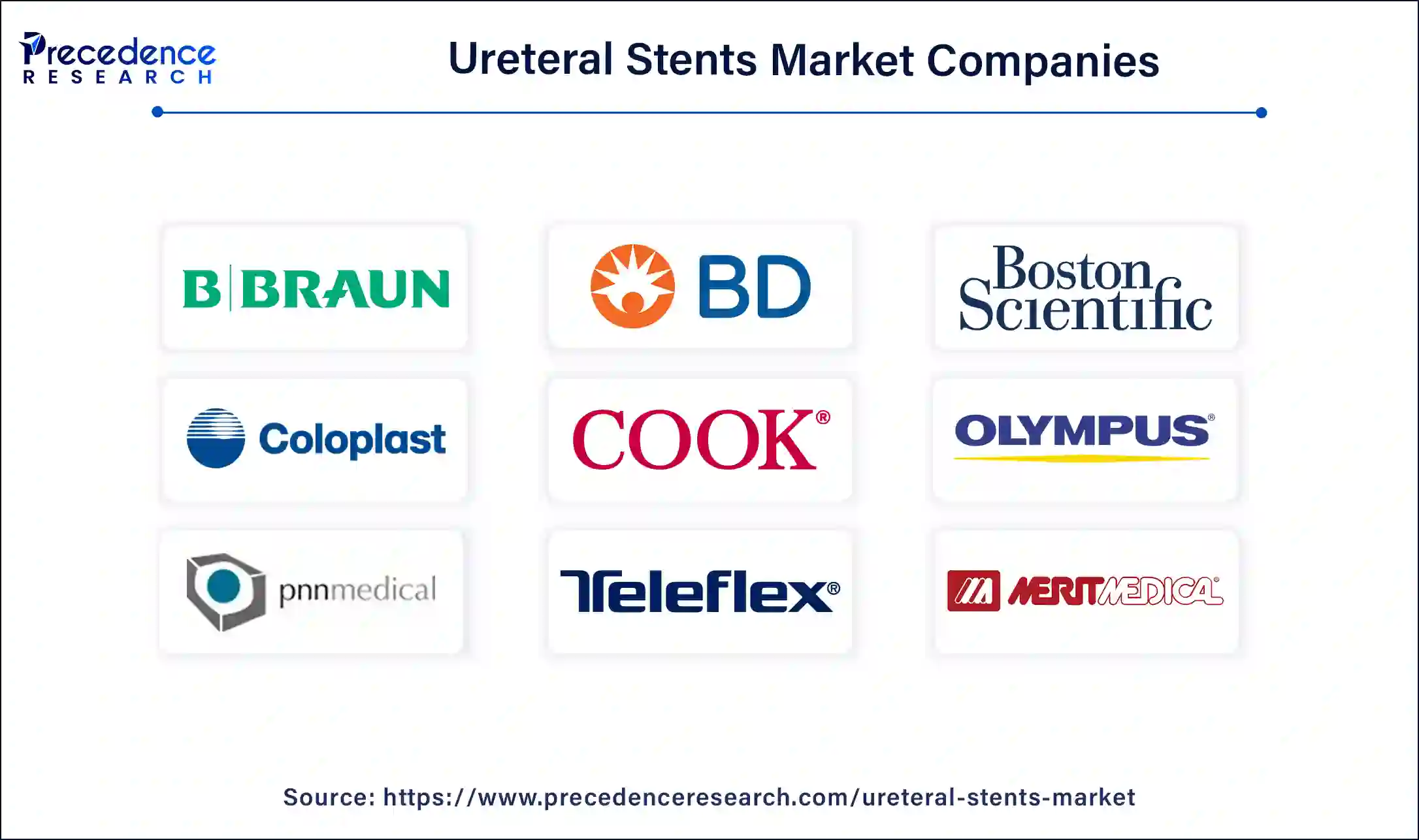
By Material
By Application
By Geography
For inquiries regarding discounts, bulk purchases, or customization requests, please contact us at sales@precedenceresearch.com
No cookie-cutter, only authentic analysis – take the 1st step to become a Precedence Research client
August 2024
January 2025
February 2025
June 2024